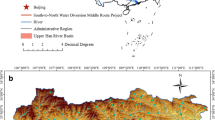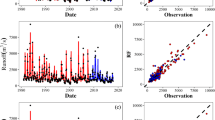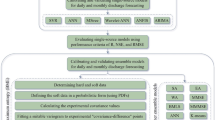Abstract
Factor selection and model construction play an important role in mid-long term runoff forecasting. Due to the indeterminacy between the data and mid-long term runoff, identifying key factors for mid-long term runoff forecasting is challenging. Another problem for mid-long term runoff forecasting is the low accuracy, which limits practical application. Aiming to solve these problems, an ensemble approach is proposed in this paper. First, we propose a novel method for constructing a comprehensive runoff index, and apply the partial mutual information approach to calculate the correlation between multiple factors and the comprehensive runoff index. Through this calculation, the key factors for the mid-long term runoff forecasting can be selected. Second, we implement mid-long term forecasting by combining improved particle swarm optimization (IPSO) and extreme learning machine (ELM) algorithms, which can improve the accuracy of runoff forecasting. The novelty of the proposed method lies in combining the construction of comprehensive runoff index, the key factor selection and the forecasting model based on IPSO-ELM for mid-long term runoff. Experimental results demonstrate that the proposed forecasting model significantly outperforms the current state-of-the-art of the extreme learning machine algorithms and other classical data-driven models for runoff forecasting in the Yalong River basin. Moreover, the performance for datasets based on different hydrological impact factors in the conducted experiments proves the robustness of the proposed method.













Similar content being viewed by others
References
Alizadeh MJ, Kavianpour MR, Kisi O, Nourani V (2017) A new approach for simulating and forecasting the rainfall-runoff process within the next two months. J Hydrol 548:588–597
Atiquzzaman M, Kandasamy J (2015) Prediction of hydrological timeseries using extreme learning machine. J Hydroinform 18(2):345–353
Bennasar M, Hicks Y, Setchi R (2015) Feature selection using joint mutual information maximisation. Expert Syst Appl 42(22):8520–8532
Chau K, Jiang Y (2002) Three-dimensional pollutant transport model for the Pearl River Estuary. Water Res 36(8):2029–2039
Chen Y, Han D (2016) Big data and hydroinformatics. J Hydroinform 18(4):599–614
Ding S, Zhao H, Zhang Y, Xu X, Nie R (2015) Extreme learning machine: algorithm, theory and applications. Artif Intell Rev 44(1):103–115
Escalante-Sandoval C, Amores-Rovelo L (2017) Regional monthly runoff forecast in southern Canada using ANN, K-means, and L-moments techniques. Can Water Resour J 42(3):205–222
Esmin AA, Coelho RA, Matwin S (2015) A review on particle swarm optimization algorithm and its variants to clustering high-dimensional data. Artif Intell Rev 44(1):23–45
Fernando TMKG, Maier HR, Dandy GC (2009) Selection of input variables for data driven models: An average shifted histogram partial mutual information estimator approach. J Hydrol 367(3–4):165–176
Han F, Yao HF, Ling QH (2013) An improved evolutionary extreme learning machine based on particle swarm optimization. Neurocomputing 116:87–93
He J, Valeo C, Chu A, Neumann NF (2011) Prediction of event-based storm water runoff quantity and quality by ANNs developed using PMI-based input selection. J Hydrol 400(1–2):10–23
Hu M, Wu T, Weir JD (2012) An adaptive particle swarm optimization with multiple adaptive methods. IEEE Trans Evol Comput 17(5):705–720
Huang W, Xu B, Chan-Hilton A (2004) Forecasting flows in Apalachicola River using neural networks. Hydrol Process 18(13):2545–2564
Huang G-B, Zhu Q-Y, Siew C-K (2006) Extreme learning machine: theory and applications. Neurocomputing 70:489–501
Huang GB, Bai Z, Kasun LLC, Vong CM (2015) Local receptive fields based extreme learning machine. IEEE Comput Intell Mag 10(2):18–29
Huang H, Liang Z, Li B, Wang D, Li Y (2019) Combination of multiple data-driven models for long-term monthly runoff predictions based on bayesian model averaging. Water Resour Manag 33(9):3321–3338
Javed K, Gouriveau R, Zerhouni N (2014) SW-ELM: a summation wavelet extreme learning machine algorithm with a priori parameter initialization. Neurocomputing 123:299–307
Jiang Z, Li R, Ji C, Li A, Zhou J (2018) Wavelet analysis-based projection pursuit autoregression model and its application in the runoff forecasting of Li Xiangjiang basin. Hydrol Sci J 63(12):1817–1830
Li H, Xie M, Jiang S (2012) Recognition method for mid-to long-term runoff forecasting factors based on global sensitivity analysis in the Nenjiang River Basin. Hydrol Process 26(18):2827–2837
Li C, Zhu L, He Z, Gao H, Yang Y, Yao D, Qu X (2019) Runoff prediction method based on adaptive elman neural network. Water 11(6):1113
Liu Y, Ye L, Qin H, Ouyang S, Zhang Z, Zhou J (2019) Middle and long-term runoff probabilistic forecasting based on gaussian mixture regression. Water Resour Manag 33:1785–1799
Marini F, Walczak B (2015) Particle swarm optimization (PSO). A tutorial. Chemom Intell Lab Syst 149:153–165
May RJ, Dandy GC, Maier HR, Nixon JB (2008a) Application of partial mutual information variable selection to ANN forecasting of water quality in water distribution systems. Environ Model Softw 23(10–11):1289–1299
May RJ, Maier HR, Dandy GC, Fernando TG (2008b) Non-linear variable selection for artificial neural networks using partial mutual information. Environ Model Softw 23(10–11):1312–1326
Qian W, Shu W (2015) Mutual information criterion for feature selection from incomplete data. Neurocomputing 168:210–220
Shannon CE (1948) A mathematical theory of communication. Bell Syst Tech J 27(3):379–423
Shoaib M, Shamseldin AY, Khan S, Khan MM, Khan ZM, Sultan T, Melville BW (2018) A comparative study of various hybrid wavelet feedforward neural network models for runoff forecasting. Water Resour Manag 32(1):83–103
Tan QF, Lei XH, Wang X, Wang H, Wen X, Ji Y, Kang AQ (2018) An adaptive middle and long-term runoff forecast model using EEMD-ANN hybrid approach. J Hydrol 567:767–780
Valipour M (2015) Long-term runoff study using SARIMA and ARIMA models in the United States. Meteorol Appl 22(3):592–598
Wang GG, Hossein Gandomi A, Yang XS, Hossein Alavi A (2014) A novel improved accelerated particle swarm optimization algorithm for global numerical optimization. Eng Comput 31(7):1198–1220
Wang WC, Chau KW, Qiu L, Chen YB (2015) Improving forecasting accuracy of medium and long-term runoff using artificial neural network based on EEMD decomposition. Environ Res 139:46–54
Wu L, Zhou H, Ma X et al (2014) Daily reference evapotranspiration prediction based on hybridized extreme learning machine model with bio-inspired optimization algorithms: application in contrasting climates of China. J Hydrol 577:123960
Xu X, Lu H, Song J, Yang Y, Shen HT, Li X (2019) Ternary adversarial networks with self-supervision for zero-shot cross-modal retrieval. IEEE Trans Cybern 50(6):2400–2413
Yao JT, Vasilakos AV, Pedrycz W (2013) Granular computing: perspectives and challenges. IEEE Trans Cybern 43(6):1977–1989
Yaseen ZM, Jaafar O, Deo RC, Kisi O, Adamowski J, Quilty J et al (2016) Stream-flow forecasting using extreme learning machines: a case study in a semi-arid region in Iraq. J Hydrol 542:603–614
Yaseen ZM, Sulaiman SO, Deo RC, Chau K-W (2018) An enhanced extreme learning machine model for river flow forecasting: state-of-the-art, practical applications in water resource engineering area and future research direction. J Hydrol 569:387–408
Ye A, Deng X, Ma F, Duan Q, Zhou Z, Du C (2017) Integrating weather and climate predictions for seamless hydrologic ensemble forecasting: a case study in the Yalong River basin. J Hydrol 547:196–207
Zhang Q, Wang BD, He B, Peng Y, Ren ML (2011) Singular spectrum analysis and ARIMA hybrid model for annual runoff forecasting. Water Resour Manag 25(11):2683–2703
Funding
This research is supported by ‘the Fundamental Research Funds for the Central Universities’(Grant No. 2017B616X14, 2018B610X14), ‘the National Natural Science Foundation of China’ (Grant No. 51420105014, 61976118) and ‘the Postgraduate Research & Practice Innovation Program of Jiangsu Province’(Grant No. KYCX18_0583).
Author information
Authors and Affiliations
Corresponding author
Ethics declarations
Conflict of interest
The authors declare that there is no conflict of interest regarding the publication of this paper.
Additional information
Publisher's Note
Springer Nature remains neutral with regard to jurisdictional claims in published maps and institutional affiliations.
Rights and permissions
About this article
Cite this article
Yue, Z., Ai, P., Yuan, D. et al. Ensemble approach for mid-long term runoff forecasting using hybrid algorithms. J Ambient Intell Human Comput 13, 5103–5122 (2022). https://doi.org/10.1007/s12652-020-02345-9
Received:
Accepted:
Published:
Issue Date:
DOI: https://doi.org/10.1007/s12652-020-02345-9




